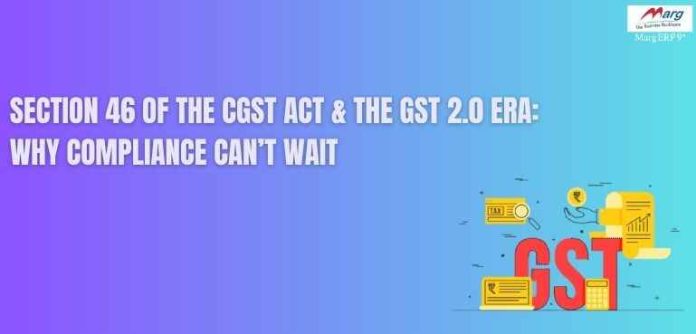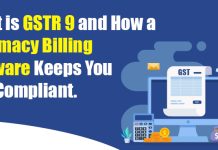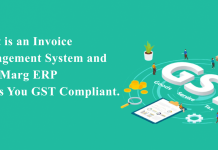Compliance is the most important part of today’s business. It enhances company’s reputation, minimises financial and regulatory risks, and improves overall operations and financial management. Therefore, you need to have a solid understanding of Sections and Clauses related to GST and other taxes.
In this passage, we will explore Section 46. It is one of the most crucial sections in the CGST Act, 2017 that you need for mandatory GST returns. Before we proceed with all details about the said section, we suggest exploring Marg ERP, India’s best billing software, for a comprehensive accounting and invoicing solution for your small and growing businesses.
Let’s begin the discussion.
What is Section 46 of the CGST Act, 2017?
Section 46 of the CGST Act, 2017 empowers income tax department to act when a registered business entity fails to file mandatory GST returns. It also includes a provision that gives return defaulters an opportunity to complete compliances before assessments and penalties begin.
The section states that if a company does not furnish a return under Section 39 (monthly/quarterly returns), Section 44 (annual returns), or Section 45 (final return after cancellation), the tax officer shall issue a notice requiring that GST return to be filed within 15 days.
If the taxpayer still doesn’t respond, the officer may proceed to a best-judgement evaluation under Section 62 of the CGST Act 2017.
Why Section 46 Matters More in 2025?
Government of India announced major GST reforms on 3rd September 2025 and is in effect from 22nd September 2025. Earlier since launch of GST in 2017, defaulters of GST Returns was relied on manual process. The mechanism has been changed from manual to digital post GST 2.0 reforms.
Upgraded GSTN system is faster, interconnected, and smarter with minimum scope of errors. Every invoice, e-way bill, e-invoice, and GST returns now feeds into one central data pool. The results are:
- Flagging of missing GST returns in real time.
- Notices related to Section 46 of the CGST Act, 2017 can be generated within days of the due date.
- Delays or errors can instantly affect your Input Tax Credit (ITC) eligibility.
The Takeaway: In the GST 2.0 environment, your compliance must be perfect, on-time and error-free. Your billing software should be comprehensive, integrated, in sync with government portals, and more.
What Changed Under GST 2.0?
Here’s how GST 2.0 has made the tax ecosystem more transparent and time sensitive. Top GST billing software like Marg ERP provides single-slot tax rates update. It helps businesses to stay compliance ready always.
| GST 2.0 Features | Impact of Business and Section 46 |
| Pre-filled Returns (auto-drafted GSTR-3B & GSTR-9) | Makes GST return filling easier. However, it leaves no room for skipped or delayed filings. |
| Real-Time Invoice Matching | Missing or incorrect invoices trigger alerts sooner. |
| Revised Tax Slabs & Rule Changes (Effective 22nd September 2025) | Organisations using outdated tax slabs may file incorrect returns. |
| Tighter ITC Validation | Disallowed credits surface quickly if vendors have not filed GST returns. |
| AI-based Notice System | With AI integration, notices under Section 46 issued instantly from portal data |
How GST 2.0 Changes the Section 46 Dynamic?
Earlier notices under Section 46 use to take weeks or even months. Under new GST regime, the detection of filing defaulters and generation of notices are way faster. Detection is instant and notice generation takes a couple of days.
It improves compliance by:
- Automated triggers when a taxpayer misses a return filing due date. The system auto-generate a Section 46 notice in for GSTR-3A.
- Reduced manual follow-up where tax officials assess portal data instead of physical inspections.
- Strong evidence trails with digitally recorded notices and responses.
Hence, it’s critical that your business prevents defaults rather than reacts to them. For an expert billing software for the same, try Marg ERP. They also provide free demo. Try, stay, and stay compliant.
How Billing Software Reduces Risks of GST Return Filing Default?
Section 46 notice only comes when you default your return filing. A billing and invoicing software prevent you from missing the deadline and ensure timely return filing. Key benefits are;
- GST Billing Software automates compliance, tax filing and return filing.
- Generates GST-compliant invoices that are in-sync with the GSTN.
- Real-time dashboards with details of pending return filings.
- Automatic reconciliation of sales, purchase, and e-invoice data.
- Alerts before due dates of returns.
How to Stay GST Ready: A 6-Step Checklist
- Keep your accounting software updated with new tax rates and rules
- Run weekly reconciliations to match invoices with filed returns.
- Use e-invoicing wherever applicable to ensure the concerned data reaches GSTN automatically.
- Check pending-return dashboards and act at least 7 days in advance.
- Respond quickly to any Section 46 notices, file within 15 days and keep digital proof of the submission.
- Maintain a compliance logs, record filings and corrections inside your GST billing software for audits.
What are the Consequences of a Missed GST Return Filling?
Section 46 comes into practice when you miss a return filing and unleash following processes.
- Day 1 to 15 after Due Date: If you don’t file, the system automatically detects the default.
- 15 days after Section 46 Notice: If you still haven’t filed, the tax personnel can issue a best judgement assessment under Section 62.
- Penalty Impact: The assessment includes estimated tax plus interest and late fee.
Therefore, even one missed GST return filing can cost you significantly. Save your business from such compliance headache with a comprehensive and secure billing software like Marg ERP 9+.
Conclusion
In the post-September 2025 GST 2.0 environment, compliance is no longer reactive, it’s data-based and real-time. Section 46 notices are now generated faster and supported by data-driven validation. Businesses that rely on manual filing or outdated systems risk penalties and assessments.
The smartest move today is to strengthen your digital foundation with a GST-compliant billing software such as Marg ERP. It keeps your invoicing, return filing, and reconciliation processes automated and up to date, so that you never miss a return or face a Section 46 notice again.




















